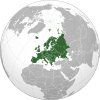|
保加利亞經濟
  保加利亚经济在1989年与苏联的经济联系失落後受到巨大打击。人民生活条件下降40%。联合国对南斯拉夫和伊拉克的经济制裁给保加利亚也带来了冲击。1994年经济开始得到恢复,但由于不充足的经济改革和不稳定的银行系统,1996年经济再次垮台。从1997年起经济得到恢复。2003年人民生活水平有望恢复到1990年代前的水平。 保加利亚传统上是一个农业国,玫瑰、酸奶和葡萄酒历来在国际市场上享有盛名。工业目前以食品加工业和纺织业为主,旅游业近年来也有所发展。保加利亚是中欧自由贸易协定组织的成员。 货币政策因为1996-1997年保加利亚经济危机,保加利亚货币列弗兑美元汇率从77:1(1996年年中)剧贬到3000:1(1997年年初),年通涨率从310.8%(1996年底)飆升到2047%(1997年3月),国内生产总值下降了10.1%。 1997年5月保加利亚接受国际货币基金组织的条件,7月1日,保加利亚中央银行实行联系汇率制列弗与德国马克挂钩:1000列弗兑1德国马克。银行利率由160%(4月)降到6%(10月),实现了金融稳定。目前保加利亚的联系汇率制是1.95583列弗兑1欧元。 參考資料
|
||||||||||||||||||||||||||||||||||||||||||||||||||||||||||||||||||||||||||||||||||
Index:
pl ar de en es fr it arz nl ja pt ceb sv uk vi war zh ru af ast az bg zh-min-nan bn be ca cs cy da et el eo eu fa gl ko hi hr id he ka la lv lt hu mk ms min no nn ce uz kk ro simple sk sl sr sh fi ta tt th tg azb tr ur zh-yue hy my ace als am an hyw ban bjn map-bms ba be-tarask bcl bpy bar bs br cv nv eml hif fo fy ga gd gu hak ha hsb io ig ilo ia ie os is jv kn ht ku ckb ky mrj lb lij li lmo mai mg ml zh-classical mr xmf mzn cdo mn nap new ne frr oc mhr or as pa pnb ps pms nds crh qu sa sah sco sq scn si sd szl su sw tl shn te bug vec vo wa wuu yi yo diq bat-smg zu lad kbd ang smn ab roa-rup frp arc gn av ay bh bi bo bxr cbk-zam co za dag ary se pdc dv dsb myv ext fur gv gag inh ki glk gan guw xal haw rw kbp pam csb kw km kv koi kg gom ks gcr lo lbe ltg lez nia ln jbo lg mt mi tw mwl mdf mnw nqo fj nah na nds-nl nrm nov om pi pag pap pfl pcd krc kaa ksh rm rue sm sat sc trv stq nso sn cu so srn kab roa-tara tet tpi to chr tum tk tyv udm ug vep fiu-vro vls wo xh zea ty ak bm ch ny ee ff got iu ik kl mad cr pih ami pwn pnt dz rmy rn sg st tn ss ti din chy ts kcg ve

